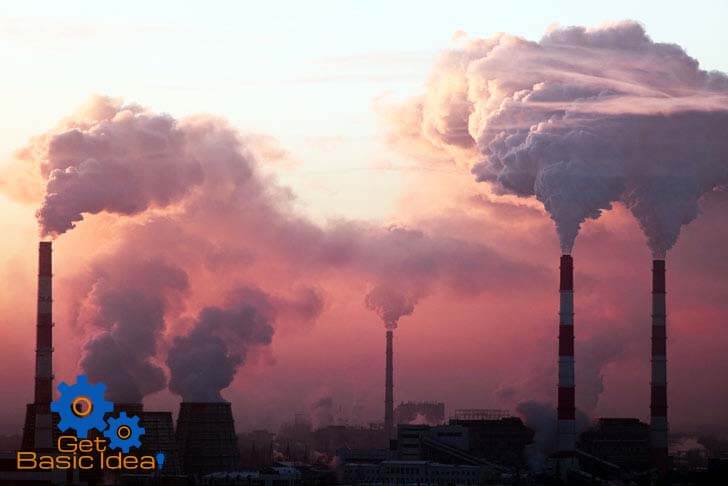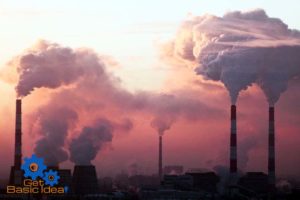Air pollution can be defined as the introduction of various material that cause harm or discomfort to living being including humans, natural vegetation and structures in to the atmosphere. These materials can be chemicals, particulate materials or biological materials which have the capability of acting adversely on natural ecosystem when they present in a sufficient concentration.
What is an air pollutant?
Air pollutant is a substance present in a sufficient concentration in air that can produce a harmful effect on human and other living beings, vegetation or materials.
Types of air pollutants.
There are two types of air pollutants.
- Primary air pollutants.
- Secondary air pollutants.
Primary air pollutants.
A primary air pollutant is a substance that has been added directly to the air in a sufficient concentration from a given source. Even though it is a natural component of the atmosphere if it rises above certain level, it can act as a pollutant.
Ex:
- Oxides of carbon (CO, CO2).
- Oxides of nitrogen (NO, NO2).
- Oxides of sulfur (SO2, SO3).
Secondary air pollutants.
Secondary air pollutants are the substances that formed in the atmosphere through chemical reactions involving normal or added component of air.
Most of these pollutants are produced due to various human activities such as industrial processes, transport, power generation, incineration of solid waste, burning of inorganic and organic materials etc.
Major classes of air pollutants, examples, and their sources.
[g_article_ads]
| Class of pollutant | Examples | Major sources |
| Oxides of Carbon. | Carbon dioxide (CO2). Carbon monoxide (CO). |
Respiration. Burning of fossil fuels as coal, oil, natural gas. Exhaust fumes of motor vehicles, industrial processes. |
| Oxides of Sulfur. | Sulfur dioxide (SO2 ). Sulfur trioxide (SO3). |
Power plants. Combustion of petrol and diesel in motor vehicles. Industrial processes. Incineration of solid waste. Forest fires. Volcanic eruptions. Combustion of coal. Decomposition of limestone. Various metallurgical processes. |
| Oxides of Nitrogen. | Nitrogen monoxide (NO). Nitrogen dioxide (NO2). |
Combustion of organic nitrogen compounds in petrol or diesel. Lightening. Industrial processes. |
| Hydrocarbons. | Methane (CH4). Butane (C4H10). Benzene (C6H6). |
Decomposition of organic matter under anaerobic conditions. Unburnt fuel from automobile. Industrial processes. Pesticides used in agriculture. Aerosols. |
| Photo-chemical Oxidants. | Ozone (O3). Peroxyacylnitrates (PAN). |
Operation of photocopiers and laser printers. Reactions of O2 in the presence of UV light and NO. Reaction between atomic oxygen and hydrocarbons from unburnt gasoline. |
| Particulates. | Soot. Dust. Asbestos. Salt spray. |
Aerosol. Human activities such as land cleaning. Forest and domestic fires. Combustion of fossil fuels by vehicles and Industries. Volcanoes. Indoor cooking using firewood. Soil and rock debris. Sea salt spray. |
| Other inorganic compounds. | Hydrogen sulfide (H2S). Sulfuric acid (H2SO4). |
Anaerobic oxidation of sulfur containing organic compounds. Acid rain. Industrial processes. Farms. |
Adverse effects of air pollution.
[g_article_ads]
- Air pollution can cause harmful effects on all living beings and other ecosystems.
- Poses potential health hazards on humans such as cancers, ischemic heart disease pneumonia, bronchitis, asthma and other pulmonary diseases.
- Can produce acid rain due to increased amount of sulfur and nitrogen oxides in the atmosphere.
- Global worming due to greenhouse effect.
- Formation of photo-chemical smog.
- Visibility problems for motorists and airplanes.
Control of air pollution
- Reduce the number of vehicles used:
This can be done by encouraging the usage of public transport so that public transportation system should be improved. - Toxic gases in automobile exhaust fumes could be controlled by introducing catalytic converters for vehicles:
Installation of catalytic converters along the exhaust pipes of vehicles can reduce the amount of unburnt hydrocarbons, CO, NO and NO2 in the exhaust fumes. These catalytic converters contain thin film of an inert metal such as platinum or palladium and also transition metal oxides such as those of chromium and copper. So unburnt hydrocarbons and CO is oxidize to CO2 and H2O and also reduce NO and NO2 to N2 and O2.
- Since N2O is thermodynamically unstable, it decomposes further into nitrogen and oxygen.
- Sulfur dioxide from industrial plants along with particulates can be removed by electrostatic precipitators.
- SO2 can be removed also by reaction with limestone (CaCO3), magnesia (MgO) or by the converting it to sulfuric acid (H2SO4).
- Scrubbers can be used along the exhaust pipes of industries and power generation plants to absorb pollutant gases.
Admin of Get Basic Idea / Senior Solution Architect.


